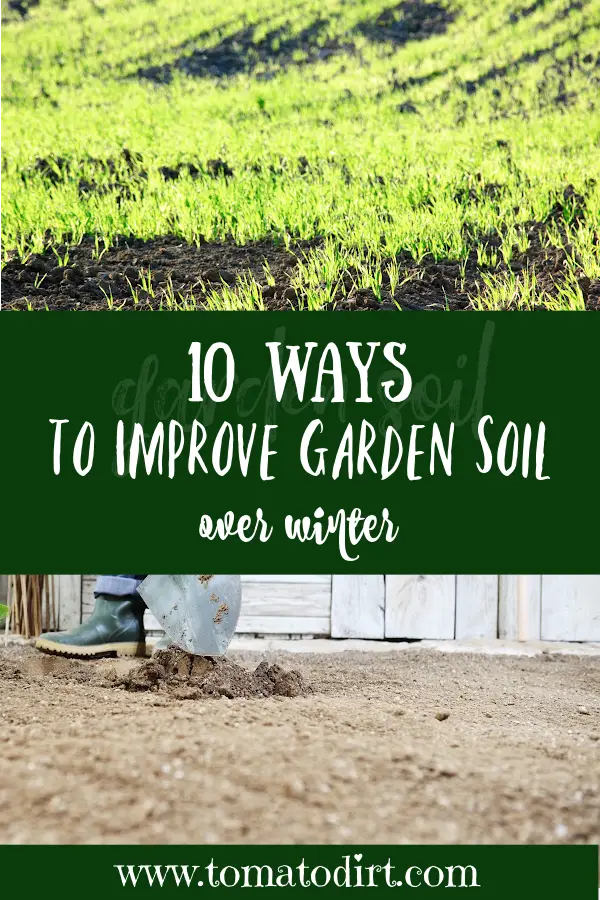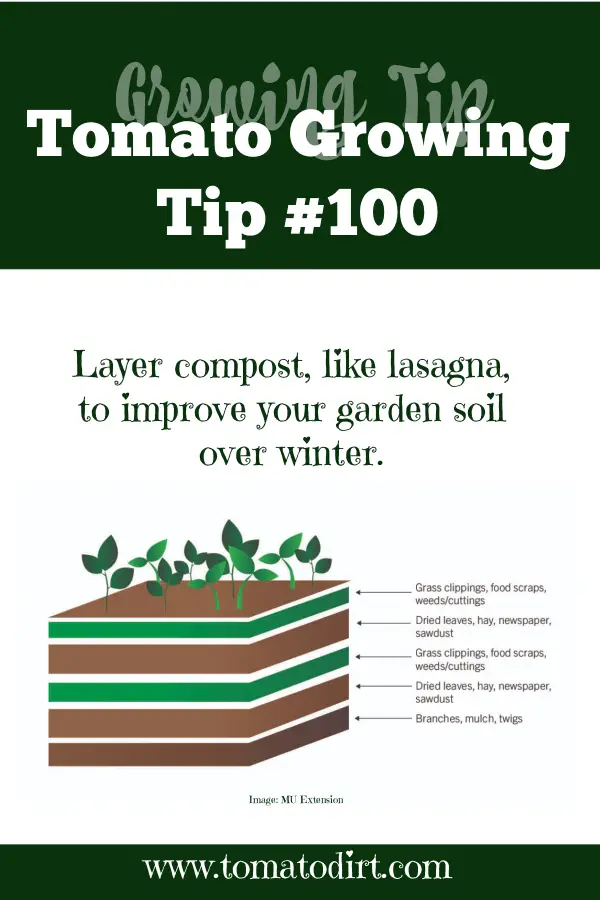FREE: 10 Must-Know Tomato Growing Tips Get The Guide
Read our affiliate disclosure here.
How To Improve Your Garden Soil Over Winter
Since 2010, Tomato Dirt has garnered 4.8+ million views, making it the web’s leading online source for growing tomatoes in the home garden. Award-winning writer and Tomato Dirt owner Kathy Widenhouse has helped thousands of home gardeners grow healthier tomatoes. Be one of them when you get Tomato Dirt’s Growing Guide here.
Posted 10.28.24
When you know how to improve your garden soil over winter, you can take simple steps to get a head start on next year’s growing season.
Just a few adjustments can make your soil a more welcoming place for next year’s plants to live. Improving the soil increases its fertility – its nutrient content, pH, and microbial activity. Plus, improving your garden soil means a better soil structure – the ideal balance of air, water, and sand/silt/clay that roots need to grow and thrive.
How to improve your garden soil by using Father Time
Act now to improve your garden soil and you have an ally that you cannot buy or create: time.
It takes time for organic matter to decompose. It takes time for air and moisture to circulate through compacted soil. It takes time to test your soil and adjust pH and nutrient levels.
Use the off season to build up your soil. You can do so with a few simple steps. And you’ll save time in the spring by letting Father Time work for you while your garden rests and
1. Plant cover crops (green manure)
- Why: Cover crops like clover, winter rye, and vetch protect the soil from erosion, suppress weeds, and add organic matter.
- How: Plant them in the fall after your last harvest. In spring, cut them down and till them into the soil to decompose, enriching the soil with nutrients.
2. Add organic mulch
- Why: A thick layer of mulch, like straw, leaves, or compost, protects the soil from compaction, retains moisture, and gradually breaks down to improve soil texture and nutrient content.
- How: Apply a 3-4 inch layer of mulch in late fall after cleaning up the garden. It will break down over winter. And you can also till its remains into the soil in the spring when you prepare the plot for planting.
3. Add prepared compost
- Why: Compost adds essential nutrients, improves soil structure, and promotes beneficial microorganisms.
- How: Spread a layer of compost (2-3 inches) over the soil in the fall. By spring, it will have worked its way into the soil.
4. Apply manure
- Why: Well-rotted manure is an excellent source of nutrients, especially nitrogen.
- How: Find a local farmer or horse owner who is willing to part with some of his animals’ droppings. Apply manure in late fall so it can break down over winter and be ready for planting in the spring. Be sure to use well-composted manure to avoid burning plants.
5. Incorporate leaves
- Why: If you have trees in your yard, you needn’t collect leaves and bag them as garden waste. Fallen leaves are rich in organic matter. When they break down, they enhance soil fertility.
- How: Shred and till leaves into the soil or use them as a winter mulch to protect soil life.
6. Test your soil
- Why: Testing your soil in fall helps determine nutrient deficiencies. This allows for tailored amendments like lime (to raise pH) or sulfur (to lower pH).
- How: At the end of the season, take a garden soil sample and send it to a lab. Or use a home test kit. Apply amendments according to the test results. Keep records in your garden journal. Repeat the process in early spring. Refer to the fall’s readings to see what’s different and what needs amending before planting.
7. Make winter compost
- Why: Even in winter, you can continue to compost kitchen scraps and garden waste to boost organic matter.
- How: If you don’t have an outdoor compost pile or compost bin, start one now. Maintain it throughout winter. Some gardeners also bury kitchen scraps directly in the garden. They will decompose over winter.
8. Add wood ash
- Why: Wood ash from untreated hardwoods adds potassium to the soil and raises soil pH.
- How: Do you have a wood burning fireplace or firepit? Scoop out cooled wood ash and sprinkle it lightly over the garden soil. Be sure to spread it evenly and over-application. Too much ash can make the soil too alkaline.
9. Sheet mulching (“lasagna gardening”)
- Why: This method improves soil fertility and texture without tilling.
- How: Once you’ve cleared out your garden for the fall, layer organic materials directly on the top of your soil. You can use cardboard, compost, grass clippings, and leaves. Over winter, these materials break down to enrich the soil.
10. Protect the soil with row covers
- Why: Do you live in a harsh climate? Winter winds and severe weather can erode and compact soil. Row covers or tarps protect the soil structure, prevent soil loss, and help retain moisture.
- How: Cover garden beds with fabric or plastic row covers, securing them around the edges.
How to improve your garden soil over winter
You needn’t take all these steps. Start with one or two or a handful. Put them into practice to give your garden a head start for next season – and you’ll grow a healthier, more productive crop.
More tips for fall garden clean up
Free Download: Fall Cleaning Check List for Your Vegetable Garden ...
How to Get Started with Tomato Garden Fall Clean Up ...
When to Remove Tomato Plants in the Fall ...
How to Prepare Your Garden for Winter ...
How to Winterize Your Garden ...
3 Mistakes to Avoid When You Prepare Garden for Winter ...
How to Take End of Season Notes about Your Tomato Garden ...
Get more tips on our Garden Clean Up Pinterest board...
Return from How To Improve Your Garden Soil Over Winter
to Tomato Dirt home
As an Amazon Associate and Rakuten Advertising affiliate I earn from qualifying purchases.
SHARE THIS PAGE:
FREE! 10 Must-Know Tomato Growing Tips: 20-page guide
Get yours here:





